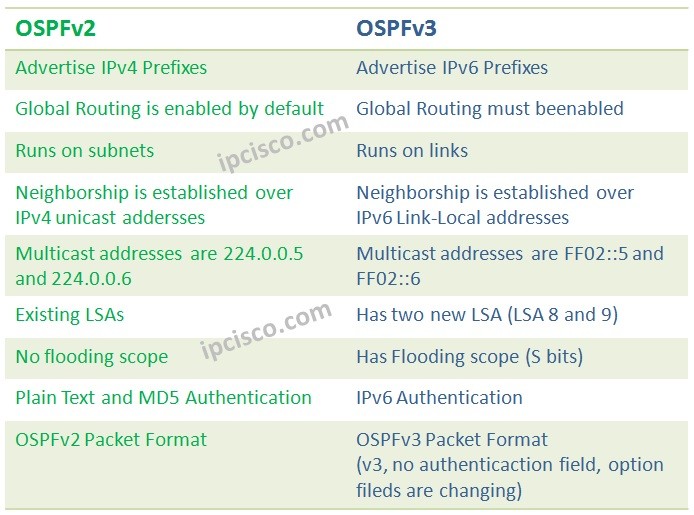- COURSES
- SPECIALS
- BLOG
- MEMBERS
- SHOP
- ABOUT
- ENROLL HERE

OSPFv3 is a new version of OSPF protocol that is developed for IPv6. The previous version, OSPFv2 was only used for IPv4. With the IPv6 revolution, routing protocols have also changed and new versions of routing protocols developed. OSPFv3 is one of the routing protocols developed for IPv6. In this lesson we will talk about OSPFv3 vs OSPFv2.
Mainly OSPFv3 is similar to the previous version of OSPF, OSPFv2. But in details, there are some differences in OSPFv2. Here, we will talk about OSPFv2 and OSPFv3 together by doing a comparison between these protocols also. You can also visit Configuration lessons to learn How to Configure OSPFv3 or How to Configure OSPFv2.
Table of Contents
As you know OSPFv3 and OSPFv2 are the two versions of OSPF protocol. So, they have some common characteristic. Here to learn OSPFv3 vs OSPFv2, firstly, we will talk about the Similarities of these two protocol versions.
Here are the similarities of OSPFv3 and OSPFv2:
Basically OSPFv2 and OSPFv3 are same, especially for main characteristics. With OPSFv3, only some extensions are coming. Let’s talk about these enhncements by checking the difference of these two protocols.
After similarities, lets talk about the differences related with OSPFv3 vs OSPFv2.
OSPFv3 is the OSPF version that supports IPv6. OSPFv3 advertises IPv6 routes. The previous version of OSPF, OSPFv2 is advertise IPv4 only.
In OSPFv2, the OSPF process runs on the networks. But in OSPFv3, OSPF process runs on the links instead of network or in other words subnets. Remember, during OSPFv2 configuration, we were adding the networks/subnets under OSPF process. In OSPFv3, we are not adding networks/subnets under the OSPF process . Instead, we are adding the links to the OSPF network.
In a single link, we can use multiple subnets. One more thing, in OSPFv3 we do not need to share a common subnet for the communication of two nodes. And there is no need for Network mask to form adjaceny. OSPFv3 adjaceny is established over link local addresses.
In OSPFv2 there were seven basic LSA types. In OSPFv3, these seven LSA types are being used too. But here, OSPF Type 3 and Type 4 LSAs has different roles and names. OSPF Type 3 LSA is now called inter-area-prefix-LSA and OSPF Type 4 LSA is now called inter-area-router-LSA.
Beside these seven LSA types, with OSPFv3 additional two LSA types are coming. “Link LSA” and “Intra-Area Prefix LSA” is these two new LSA types.
The aim of “Link LSA” is notifying link-local addresses, informing other routers attached to this link and allow the router to assert the collection of option bits for the association with the network LSA of this link. Link LSA is originated by the router for each link that it is attached.This LSA is in link-local scope, so it is never flooded.
The “Intra-Area Prefix” LSA is used for advertising IPv6 prefixes associated with the router, and attached stub or transit network.
The two bit of the LSAs indicates “Flooding Scopes“. These bits are called “S bits“. What are these flooding scopes? Flooding Scopes used in OSPFv3 are listed below:
Leave a Reply